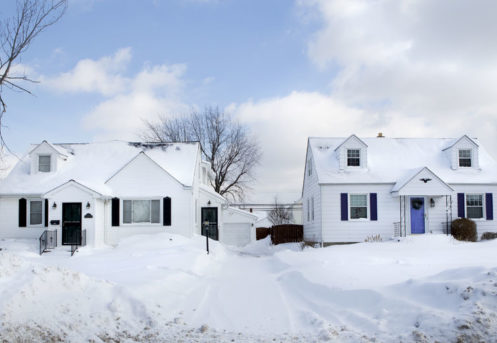When the outside temperatures are at their highest, the air conditioner in your Cobourg, Ontario home is indispensable. Without it, your living environment would be too hot, muggy, and oppressive to enjoy. However, when the cold season comes rolling in, you shouldn’t forget your AC system entirely. Severe winter storms are guaranteed to take a serious toll on your home cooling equipment if it isn’t duly protected. That’s why it’s important to take the following eight steps to prep your air conditioner for the extreme weather that lies ahead.
1. Shut Your Air Conditioner Down to Keep It From Accidentally Powering Up
If you keep your thermostat set at a moderate temperature in winter, there’s always the risk of having your air conditioner kick into action on warmer days. Not only is this a waste of energy, but it can also cause your condenser to take moisture in. With nowhere to go and lacking temperatures high enough to dry it up, this moisture can cause corrosion at the interior of your AC condenser that shortens its lifespan.
To prevent this, find the power switch to your air conditioner condenser. This should be mounted beneath a flip lid on the wall closest to the unit. For added surety, turn the air conditioner off at the circuit breaker as well.
2. Clean Up Autumn’s Debris
Warmer and drier than winter, autumn is often a time of heavy wind. Not only do the trees on your property and on surrounding properties shed their leaves, but a lot of loose, organic materials are being blown around. Before retiring your air conditioner for the cold season, take the time clean it. Get your rake and yard broom out to collect bird or other animal droppings, branches, leaves, dead bugs, and lawn clippings that have accumulated around the outdoor unit.
3. Limb Your Trees
For homeowners with multiple trees on their properties, regular tree limbing is essential for preventing costly and potentially devastating premises liability issues. This is the process of removing weak or dying tree limbs before they break off and fall. Regular limbing will prevent heavy branches from dropping onto people and property. Taking care of this task is the fulfillment of your “duty of care” or the efforts that all property owners must make to keep people safe while on their grounds.
If one or more of your trees is right near your AC condenser, there are obvious benefits in having these trees limbed before heavy snowfall and strong winds arrive. If you have trees that overhand a neighbor’s condenser, be sure to have these limbed as well.
4. Check Your Roof
One large part of protecting your air conditioner in winter is taking good care of your roof. If your roof has heavy shingles or if your gutters and downspouts are starting to detach, have them repaired right away. These things can cause major damages to your air conditioner upon impact.
Before winter arrives, schedule a roof inspection to make sure that everything is secure. Not only will this keep your condenser protected, but it will also give your roofer the opportunity to catch and correct minor areas of weakness or damage before the tests and trials of the cold season arrive.
5. Remove Clutter From Your Backyard
Never underestimate what the wind can do. If there’s ever a good reason to store your patio furniture or your kids’ toys, protecting your AC condenser is it. If there are any heavy items that aren’t securely mounted, store these things in your shed, attic, or basement. If a severe weather event brings heavy winds into your area, you won’t have to worry about bicycles, slides, tables, or chairs crashing into your air conditioner.
6. Establish a Solid Plan for Preventing Ice Dams and Icicles on Your Roof
Icicles that hang precariously off of the edges of eaves are just as perilous as they look. When these begin melting and breaking off, they can cause serious damage to anything or anyone that’s just beneath them. Although they might seem like an inescapable part of the winter season, they’re actually a preventable issue.
Icicles typically form on roofs that have regular problems with ice damming. Insufficient attic insulation and poor roof maintenance are commonly responsible for ice dams as is insufficient snow removal. Heat loss from your house paired with freezing outdoor temperatures can facilitate rapid snow melt and equally rapid refreezing. If ice dams are left unchecked, issues with icicles will occur all season long, and you’ll have to cross your fingers and hope that a single, falling icicle doesn’t instantly render your condenser inoperable.
Much like other heavy, falling debris, falling icicles can bend the unit’s coils and its guard out of shape. If your condenser is fairly close to your gutters, the blunt impact of a falling icicle can even damage the unit’s fan. Worse, still the underlying cause of icicles (ice dams) can eventually undermine the integrity of your roof and lead to moisture damages at the building interior. To limit the development of icicles and to prevent ice dams from forming, try:
- Adding more attic insulation to prevent heat loss
- Sealing air leaks at all air outtake vents, chimneys, and flues
- Checking and replacing missing, torn, or loose flashing
- Clearing all ridge vents and soffit vents to ensure good attic ventilation
- Cleaning out your gutters before a severe weather event and immediately after
If ice dams and icicles are a recurring problem on your roof, you can also have your roofer install heat cables that will reliably melt excess snow and ice before they have the opportunity to refreeze. Finally, if your roof doesn’t have a steep slope and if you won’t be installing heat cables, establish a solid schedule for regular snow removal so that falling mounds of snow don’t exceed your condensers load-bearing limit.
7. Build a Wind Barrier
Ultimately, the location of your AC condenser will determine just how vulnerable it is to weather-related damages during winter. Units that are especially close to homes have a higher likelihood of getting hit by falling icicles, heavy snow loads, and loose roof tiles. However, being close to a home also limits wind exposure, as does having a nearby fence, or shed. These structural barricades can limit the amount of debris that gets blown towards and into your AC condenser.
The best wind barriers are securely mounted and unlikely to get blown over or shed debris themselves. Installing a wind barrier may be a good idea if your condenser sits far back from your home and isn’t sheltered by fencing or a neighboring building. You can talk with your HVAC company about choosing the right barrier type based upon the layout of your yard, the location of your condenser, and the types of wind-blown debris that this unit is subject to.
At Comfort Zone Heating & Air Conditioning, we provide heating, cooling, and indoor air quality services to residents of Cobourg, Ontario and the surrounding area. We also offer heat pumps and water heaters. If you need help getting your air conditioner winter-ready, call us today.




